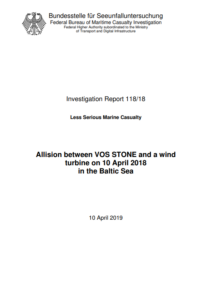The German Bureau of Maritime Casualty Investigation published its report on the offshore supply vessels Vos Stone, which hit a wind turbine under construction. Both the ship and the turbine were damaged, while three people sustained minor injuries.
The incident
On 10 April 2018, Vos Stone was operating in the AOWF at TP AB01, a wind turbine under construction. While the team was making the necessary preparations to to feed the cable at TP AB01, they were called back due to deteriorating weather conditions.
The return of the ship was carried by means of an Ampelmann gangway and was completed a littler later.
[smlsubform prepend=”GET THE SAFETY4SEA IN YOUR INBOX!” showname=false emailtxt=”” emailholder=”Enter your email address” showsubmit=true submittxt=”Submit” jsthanks=false thankyou=”Thank you for subscribing to our mailing list”]
Just minutes after casting off from the wind turbine, the master decided to test an emergency control system, which resulted in the loss of control of the ship.
The wind and waves pushed Vos Stone back against TP AB01. The 1/O regained control of the ship shortly before the allision, but there was no longer sufficient time to prevent it.
The platform sustained minor damage, while three crewmembers onboard the Vos Stone suffered minor injuries as a result of the impact. In addition, the damage to the ship was so bad that it had to call at a shipyard.
Probable cause
BSU was not able to conclude what made the master test the new emergency control system. The vessel was sailing into a freshening wind and still within the limits of the AOWF. BSU said that the master took an unnecessary risk in testing the ship’s emergency control system.
Moreover, the 2/O was not fully conversant with operating the DP. As a result, ship management should continue to ensure that navigators are conversant with the specific technology of this ship.
What is more, internal communication between navigators on the bridge could be better. The master should inform the OOW of his intentions and actions, so as to avoid complications.
Finally, bridge management after the accident was poor.
Recommendations
After the accident, the operation company VBMS established a list of points that needed to be worked on, before the ship starts operation again. These include:
- Training program for DP operators must comply with IMCA standards;
- One additional, experienced SDPO must onboard;
- The procedure for selecting the operating mode for transfer must be verified in consultation with the sister ship and the manufactures of the DP system;
- The ship’s standing orders must be updated to specify who is in command during watch;
- Standing orders of the master should be harmonised throughout the Vroon fleet;
- The annual DP tests on the Vos Stone scheduled for June 2018, will be brought forward and performed after the repair of the ship;
- The IJS cJoy is an emergency system and should not be used while sailing between the TPs in the construction field;
- The procedure for the switch over process must be updated in the DP manual;
- Vroon Offshore Servies must prepare and communicate to all ships of its fleet a safety notice, which indicated the potential for error when using the manual switch over of the DP with the IJS.
See more details into the accident, in the PDF below































































